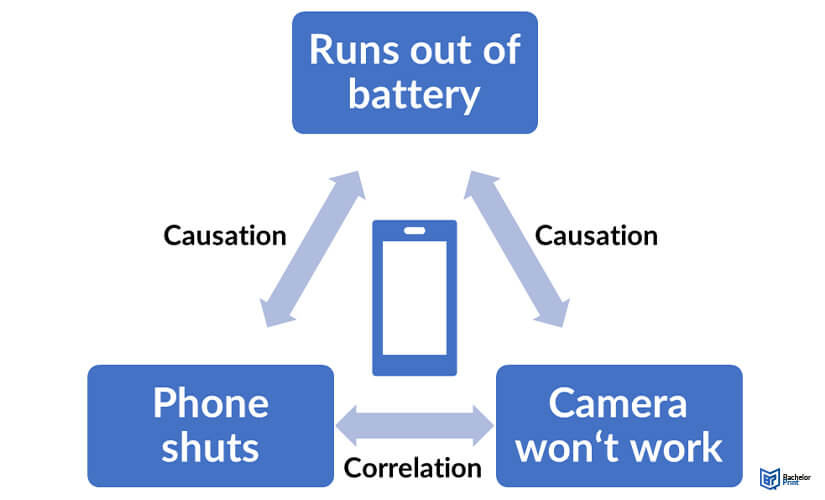
Correlation and causation, both crucial methodologies in the field of research, play distinct roles in the interpretation of data relationships. While correlation quantifies the degree to which two variables move in tandem, causation goes a step further to illustrate a cause-and-effect relationship, thus providing deeper insights into data analysis. Many fields of study utilize data in research to discover patterns and meaning. While correlation and causation may seem similar at face value, they are different.
Definition: Correlation vs. Causation
Correlation vs. Causation is differentiated as the following: correlation means there is a pattern or link between variables. While the meaning of this pattern may not be clear, it’s apparent that when one variable changes, the other does too. This joint change is known as covariance. Causation, by contrast, means that change in one variable brings about real change in the other. This is otherwise known as a cause-and-effect relationship, like how smoking cigarettes has been scientifically proven to increase the risk of developing lung cancer.

How to differentiate correlation vs. causation
The best way to break down correlation vs. causation is as follows: causation and correlation can exist together, but correlation doesn’t always mean causation. The human mind tends to find patterns even when they’re not there. This need for patterns creates issues like gambling fallacies, where individuals erroneously believe that an outcome, like the result of a dice roll, will occur based on a previous event. This is a causal and correlation fallacy because there is no link between one roll of the dice with another.
Our need to discover patterns may lead us to incorrectly assume a causal link between variables. However, we cannot automatically assume this link if the relationship isn’t scientifically tested. There could be a wide variety of variables that we don’t know about, from external causes to chain reactions and other external factors.
Correlation vs. Causation: Correlation does not imply causation
Two of the most common problems that can influence causation are the third variable problem and the directionality problem. Without understanding these, you risk conducting bad science and, ultimately, poorly constructed research.
The third variable problem:
- Means the existence of a third, confounding variable.
- Works in a way that makes causality appear in the first two variable.
- It is one of the more common missing pieces when drawing up correlations.
The directionality problem:
- It is when two variables appear to truly correlate, but it’s impossible to discover which influences the other.
- Has a causal link that could work both ways, indicating a need for further research.
- May still indicate a third variable.
Correlation vs. Causation research
When identifying correlation vs. causation, you’ll need to conduct the appropriate research design. As the names suggest, correlation research highlights links between variables while causation research proves causal relationships. In the below, we will distinguish between research in correlation vs. causation.
Correlational research
With correlation research, the aim is to gather data to investigate links between two variables with no manipulation. The methodology used depends on your research and can include observation, archival records, and surveys. Correlation research is more commonly applied in college papers, where controlled experiments are too costly or unethical. It has high external validity in that you can generalize results with a larger external source.
The third variable problem in correlation vs. causation
A third (or extraneous) variable problem is used to describe any additional variable that’s affecting change in your correlation vs. causation results. Without conducting experiments in a controlled environment, it’s difficult to pinpoint a causal link between variables. There could be other correlation vs. causation influences. These confounding variables can make correlation seem causal when it isn’t.
Spurious correlations in correlation vs. causation
In correlation vs. causation, a spurious correlation means that two variables appear to be linked through some unknown variable.
The directionality problem in correlation vs. causation
Directionality gets to the heart of correlation vs. causation. To demonstrate a causal relationship, you must identify the direction of the cause’s effect. A directionality problem arises when this direction isn’t clear. Furthermore, while most causal relationships work one way, some are more complex with variables impacting each other. Correlation research won’t be able to identify this directionality, and you may even identify the wrong direction.
Causal research
To identify correlation vs. causation relationships, you need to conduct a controlled experiment. This isolates variables to establish the direction of causality. This is done by manipulating one variable to measure the response in another. As change is recorded after the experiment is conducted, a strong causal link may be considered.
Just as causal research can identify the direction, it eliminates the influence of unknown variables. This is done through controlled grouping. With randomized assignment in test groups, you control the conditions to test correlation vs. causation. As a result, causal research is high in internal validity, demonstrating an absence of extraneous factors and third variables which can muddy data in real life.
FAQs
Correlation means there is a relationship between two variables. Causation describes the relationship as causal, i.e., change in one variable leads to change in another.
By understanding the causal link between two variables, you can make goals for effective outcomes. For instance, knowing that a marketing campaign has increased sales allows a company to project marketing growth.
Some of the few ways to accurately establish causal links is with controlled studies and randomized experiments. Without this empirical evidence, the relationship cannot be truly defined and thus remains only correlative.
“Dinosaurs didn’t read, now they are extinct. Thank goodness the thesaurus survived”. This popular joke is built on a humorous but fallacious causal link.
